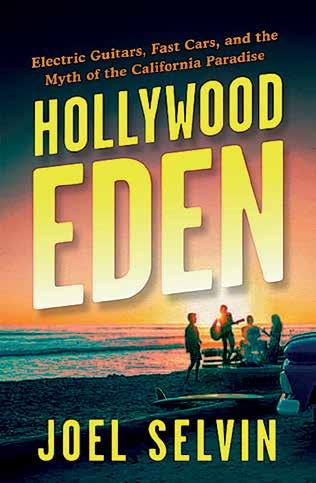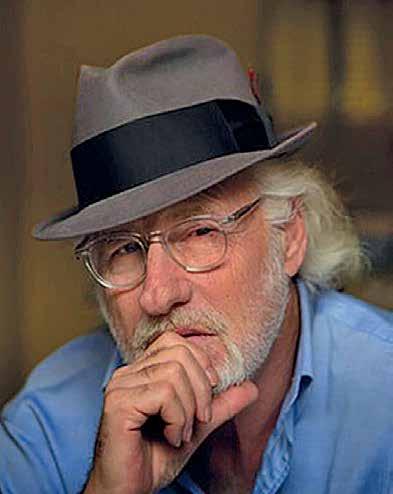
8 minute read
Hollywood Eden
HIGH SCHOOL GOES HOLLYWOOD
Joel Selvin Delves Into the History of Southern California Music & Entertainment
Advertisement
BY LEE VALENTINE SMITH
EVEN CURSORY FANS OF MUSIC history will surely enjoy the fascinating glimpse of the elusive California Dream mythology as told by renowned music scholar and general raconteur Joel Selvin. In Hollywood Eden: Electric Guitars, Fast Cars, and the Myth of the California Paradise, the prolific writer details the incredible microcosm of art, fame and privilege of the sunny SoCal scene. Incredibly he manages to cover an incredible sweep of time, beginning with the innocence of 1958 concluding in the self-awareness of fall of 1966 as a jaded new decade loomed ahead. Everything was poised for change and this book wisely covers the era that led up to the tumultuous ‘70s. Utilizing a narrative centered around the hallowed halls of University High School, the institute of learning that was included an incredible pedigree. Attendees included Jan Barry, Dean Torrence, Nancy Sinatra, Bruce Johnston, Kathy Kohner (the real-life inspiration for the fictionalized “Gidget” character). Turns out, the seemingly idyllic wonderland is anything but a paradise, but hey, at least they all had cool cars. Selvin has researched the era relentlessly and his story is a fascinating look into high school as seen through the eyes of some of pop culture’s iconic movers and shakers. INsite caught up the busy writer from this office near San Francisco.
This book is quite an undertaking. When you were working out the concept, how did you develop the narrative? Obviously, you can’t just throw a bunch of facts at people. There’s a crazy friend of mine that collects high school yearbooks with future celebrities’ pictures in it. He showed me the University High book and it just clicked in my brain. Soon it evolved into a vision for this book, it all grew really organically from that starting point.

Well, high school and early college is such a crucial point of life. High school is such a unique and essential American experience, one not shared by other cultures or countries. I’ve really come to see high school as this place where we get so much of our formative information, and not just the education in the classroom. I think that education might actually be the last on the list, but I mean your socialization, politicization, sexualization. All that stuff takes place in high school in an informal, but socially constructed way. Especially in the ‘50s where the generation that we call the baby boomers was just coming into this post-war wave of prosperity. Then we’d plop all that into this thing on this hillside in Santa Monica, with all these incredibly wealthy and privileged elite from Brentwood and Bel Air, with parents who were making a living in show business. Not just actors and actresses, but film directors, accountants, lawyers and studio employees of all sorts. Their kids went to University High. So of all the world and all the times, and all the places, that high school class represented these people who saw life as anything was possible for them. And guess what? Anything was possible for them. Yeah. You left it at such a great spot because everything was about to change at that moment. And boy did it. So true, you’re right. It’s right at the front step of a different world. If you go through that portal between 1966 and ‘67, then everything changes. Everything. I just didn’t want to go into that part. I wanted to just go from total innocence to self-knowledge and then just stop. The journey is complete.
and this is the story’s end and then it’s over.’ We could fill in a lot of data, but it just wouldn’t add anything to the emotional experience of the narrative arc. High school pretty much forms and informs who we are. Your own story parallels the book in many ways. That’s exactly right. One of my San Francisco hipster Well, you know, I fell into the newspaper business after I lawyer friends once told me that the only three people you dropped out of high school when I was 17. And that was the could trust were Deadheads, people in AA and friends from Summer Of Love, June, 1967. So my story begins where the high school. book ends. I went to work as a copy boy. IF YOU GO THROUGH I also got on the guest list at the Fillmore. That covers it all right there. Since we’re THAT PORTAL BETWEEN Saw Hendrix and Cream. So very early in talking about the cultural touchstone of school, this particular location was very fertile ground for so many people and ground zero for some amazing 1966 AND ‘67, THEN EVERYTHING CHANGES. EVERYTHING. I JUST DIDN’T life, I determined that I wanted to write about rock bands for newspapers. I did that for a million years. Believe me, I wrote about rock bands for newspapers so much female artists. WANT TO GO INTO THAT that I got everything out of it I ever wanted It was really important to me to bring PART. I WANTED TO JUST - and then some. So the newspaper business them out of the background because in all the previous portraits of this era, and there have been many, were strictly the boys club. The girls were on the margins as somebody’s GO FROM TOTAL INNOCENCE TO SELF-KNOWLEDGE AND THEN JUST STOP. THE came to an end or let’s just say it shifted its position. In 2009, I was one of 120 Chronicle editorial employees that left their jobs. That’s the end of the daily newspaper girlfriend. When I first thought of this book, JOURNEY IS COMPLETE. business. There were 10,000 of us on the I sought out [singer-actress, brief member streets that year. I just determined, well, of the Mamas and Papas] Jill Gibson. When she agreed to let’s just see if there’s any business in this book thing. I had cooperate, I felt like I could move forward with the project. an agent, I had books out and the first thing we cooked She was the linchpin, in fact. I intentionally brought Jill out up was a Sammy Hagar book. It was the number one New of the background. She’s anything but somebody’s girlfriend. York Times best seller. So it appeared there was definitely And when she steps forward in the final act in a real something to be done with this book thing. I think that prominent way, she really represents what it was like to be a Hollywood Eden is my 10th book or something like that female in that scene. That’s why I brought Nancy Sinatra out since 2009, when I left the papers. It’s been scribble, of the background, too. Her whole personal story parallels scribble, scribble. But it’s just like selling articles to a bunch with a generation of females trying to figure out her role in of different magazines. It’s a big hustle and you never know life. Am I a wife and mother? Am I an independent person? what the next one’s going to be or where your next year’s Am I a daughter? It’s especially poignant in her case. And income is coming from. The only difference is the writing that record, “These Books Are Made For Walkin,’” which projects take longer. That’s all. reflects this whole sort of thing that came to be called women’s liberation, was really a personal liberation for her Hollywood Eden: Electric Guitars, Fast Cars, and the and that story is spelled out in the book. The University Myth of the California Paradise (House of Anansi Press) is High class of ‘58 were living an American teenage dream available from all major book retailers. Be sure to look for and they didn’t even know it. They thought that was their Selvin’s special Hollywood Eden playlist on Spotify. real life, and it was. Nice to see some interesting history on Jan and Dean, as well. The general thinking or public perception is that Jan and Dean were Beach Boys imitators. The actuality is that the Beach Boys were Jan and Dean imitators! They had a dozen records out by the time the Beach Boys made their first record. And they established an easily identifiable style, drawn from the music we call doo-wop. And unlike the Beach Boys, both Jan and Dean actually surfed. So they got the Beach Boys to play behind them on a couple of the Brian songs for the album they were finishing up. Surf City, right? And Brian tossed off half of his... well, not even half of the song - just that line, “Two girls for every boy.” And Jan ran with it. He got a disc jockey, Roger Christian, to cough up some lyrics and Dean tweaked them. And it came back to Brian and they made the record together. But they showed Brian how to stack harmony, vocals and overdub. He used a couple of Latino guys that he knew from University High who recorded under the name The Gents. And Brian and Jan sang on it. Oddly, the only person who didn’t sing on it was Dean. That really started the whole California sound we know today. They were the beginnings of this whole Los Angeles rock and roll thing. But it doesn’t seem like people draw the mind back that far to it. And then Jan’s sort of unceremonious exit provided a perfect bookend to the story. I had an editor who very much wanted me to put a ‘Where are they now’ sort of concluding chapter or appendix or something. But I just resisted it. I thought, ‘No, man. This is the story’s beginning,







